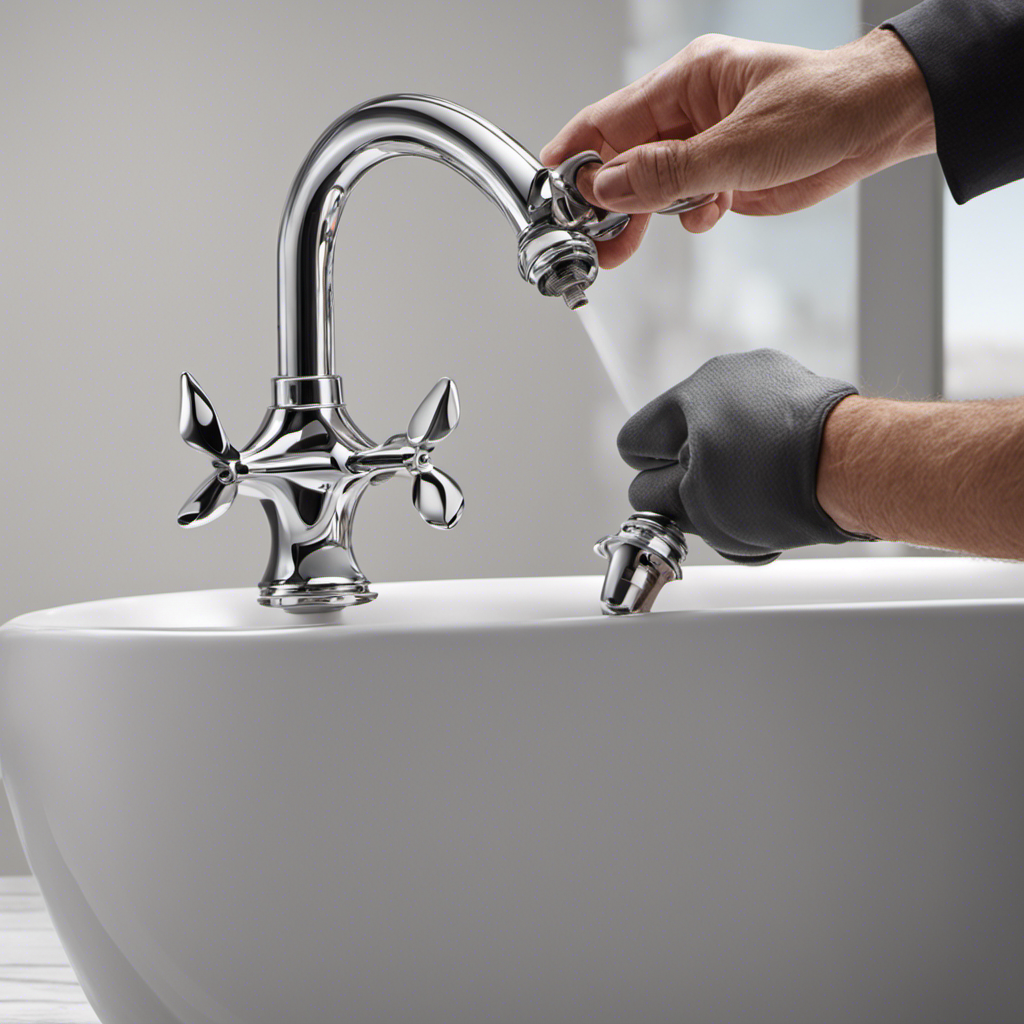Hey there! Are you tired of dealing with a leaky or outdated bathtub spout? Well, I’ve got some good news for you – changing it out is easier than you may think!
In this article, I’ll guide you through each step of the process, providing you with all the information you need to successfully replace your bathtub spout.
So, roll up your sleeves and get ready to transform your bathroom into a more functional and aesthetically pleasing space.
Let’s dive in!
Key Takeaways
- Gathering the necessary tools and materials, such as a screwdriver and plumber’s tape, is essential for changing the bathtub spout.
- Turning off the water supply is crucial to prevent water leakage during the process.
- Removing the old bathtub spout involves locating the set screw, loosening and removing it, and twisting the spout counterclockwise.
- Cleaning and preparing the spout area includes removing debris, checking for mineral deposits, inspecting for leaks, and lubricating the moving parts.
Gather the Necessary Tools and Materials
You’ll need a screwdriver and plumber’s tape to change the bathtub spout. Before beginning, make sure to turn off the water supply to the bathtub. This can usually be done by turning off the water valves located near the bathtub.
Once the water is turned off, gather the necessary tools and equipment such as a screwdriver and plumber’s tape. These tools will help you remove the old spout and install the new one.
It’s important to take safety precautions during this process. Wear protective gloves to avoid any injuries and ensure that you are working in a well-lit area.
Turn off the Water Supply to the Bathtub
To begin, make sure the water supply to your tub is turned off. This is an important step to ensure that you won’t have any water leakage while changing your bathtub spout.
Here’s a step-by-step guide on how to turn off the water supply:
-
Locate the water shut-off valve: Usually, it is located near the tub or in the basement. It may be a lever, knob, or a round valve handle.
-
Turn off the water supply: If it’s a lever or knob, turn it clockwise until it stops. If it’s a round valve handle, turn it a quarter turn clockwise until it’s perpendicular to the pipe.
-
Verify water supply shut off: Check if the water flow has stopped by turning on the tub faucet. If no water comes out, it means the water supply is successfully shut off.
-
Proceed with changing the bathtub spout: Now that the water supply is turned off, you can safely proceed with changing your bathtub spout without any risk of water leakage.
Remove the Old Bathtub Spout
Once the water supply is shut off, it’s time to remove the old spout. To begin, locate the set screw on the bottom of the spout. Using a screwdriver, loosen and remove the screw.
Next, grab the spout firmly and twist counterclockwise to unscrew it from the wall pipe. If the spout is stuck, you may need to use a pipe wrench for extra leverage.
Once the old spout is removed, take a moment to examine the wall pipe for any damage or corrosion.
Now that you have successfully removed the old spout, it’s time to consider your replacement options. There are various styles and finishes to choose from, so select one that matches your bathroom decor.
Clean and Prepare the Spout Area
First, make sure to turn off the water supply before starting the cleaning and preparation process. Cleaning and maintaining the spout area is crucial to ensure the longevity and efficiency of your bathtub spout.
Here are four cleaning techniques and maintenance tips for the spout area:
-
Remove any debris: Start by removing any dirt, grime, or soap scum that may have accumulated around the spout. Use a soft cloth or sponge and a mild cleaning solution to gently wipe away the residue.
-
Check for mineral deposits: Over time, mineral deposits can build up on the spout, affecting its performance. To remove these deposits, soak a cloth in vinegar and wrap it around the spout. Let it sit for a few hours, then scrub the spout with a soft brush and rinse thoroughly.
-
Inspect for leaks: While cleaning, check for any signs of leakage around the spout. If you notice any leaks, it may be necessary to replace the spout or call a professional plumber for repairs.
-
Lubricate the spout: To keep the spout functioning smoothly, apply a small amount of silicone or plumber’s grease to the moving parts. This will help prevent any sticking or difficulty in turning the spout.
Install the New Bathtub Spout
Before installing the new spout, make sure to turn off the water supply and remove the old spout.
Now, it’s time to install the new bathtub spout.
First, inspect the diverter valve to ensure it is in good condition. If it needs to be replaced, now is the time to do so.
Next, choose a new bathtub spout design that suits your style and preferences. There are various options available, such as wall-mounted, deck-mounted, or freestanding spouts.
Once you have chosen the design, follow the manufacturer’s instructions to install the spout.
Make sure to use plumber’s tape to create a watertight seal. Tighten any screws or fittings securely, but be careful not to overtighten.
Finally, turn on the water supply and check for any leaks.
Enjoy your new bathtub spout!
Test for Leaks and Ensure Proper Functioning
When it comes to testing for leaks and ensuring proper functioning of a bathtub spout, there are a few key points to keep in mind.
First, it’s important to know the various leak detection methods that can be used, such as visual inspection, listening for drips, or using a leak detection dye.
Next, testing the spout functionality involves checking for any issues with the diverter valve, ensuring proper water flow, and confirming that the spout is securely attached.
Lastly, to ensure proper water flow, it’s crucial to verify that the water pressure is at an appropriate level and that there are no obstructions in the spout or the plumbing system.
Leak Detection Methods
One way to identify a leak in your bathtub spout is by checking for water stains or puddles around the base. If you notice any signs of leakage, it’s important to address the issue promptly to prevent further damage.
Here are some leak prevention tips and common causes of bathtub spout leaks:
-
Inspect the spout regularly: Check for any cracks, loose connections, or worn-out parts that may contribute to leaks.
-
Replace faulty parts: If you notice any damaged or worn-out components, such as washers, O-rings, or gaskets, replace them immediately to prevent leaks.
-
Tighten connections: Ensure that all connections are properly tightened, including the spout-to-wall connection and any additional plumbing connections.
-
Avoid excessive force: Be gentle when turning the spout on and off to avoid causing damage that could lead to leaks.
Testing Spout Functionality
Now that we have discussed leak detection methods, let’s move on to testing the functionality of the bathtub spout. It is important to ensure that the spout is working properly before proceeding with any repairs or replacements. Here are some testing techniques and troubleshooting tips to help you in this process:
| Testing Techniques | Troubleshooting Tips | Maintenance Tips |
|---|---|---|
| 1. Turn on the water and check if the spout is delivering a steady stream. | 1. If the water flow is weak or uneven, there may be a clog in the spout. Try cleaning it with a wire brush or vinegar solution. | 1. Clean the spout regularly to prevent buildup and maintain optimal functionality. |
| 2. Test the diverter by pulling up on the knob or lever and observing if the water is diverted to the showerhead. | 2. If the water does not divert properly, the diverter valve may be faulty. Consider replacing it to fix the issue. | 2. Lubricate the diverter valve periodically to ensure smooth operation. |
| 3. Check for any leaks around the base of the spout. If there are any, it may indicate a faulty seal. | 3. If there are leaks, try tightening the spout or replacing the seal to eliminate the issue. | 3. Inspect the spout regularly for any signs of wear or damage and address them promptly. |
Ensuring Proper Water Flow
To ensure proper water flow, you should start by checking if the stream from the faucet is steady. This will help you determine if there are any issues with water pressure that may affect the functionality of your bathtub spout.
Follow these steps to ensure proper water flow:
-
Turn on the faucet fully: Start by turning on the faucet to its maximum capacity. Observe the stream of water coming out of the faucet to see if it is steady or if it fluctuates.
-
Check for low water pressure: If the stream of water is weak or inconsistent, it may indicate low water pressure. This can affect the performance of your bathtub spout and may require you to take steps to improve water pressure.
-
Address water conservation: If the water flow is too strong, it may be wasting water unnecessarily. Consider installing a water-saving device or adjusting the water pressure to conserve water while still maintaining proper flow.
-
Seek professional help if needed: If you notice any significant issues with water pressure or flow, it is advisable to consult a plumber who can assess and address the problem effectively.
Conclusion
Changing the bathtub spout may seem like a daunting task, but it can be done with a few simple steps.
By gathering the necessary tools and materials, turning off the water supply, removing the old spout, cleaning and preparing the area, and installing the new spout, you can have a functioning bathtub in no time.
It’s important to test for leaks and ensure proper functioning to avoid any water damage.
Did you know that a leaking bathtub spout can waste up to 90 gallons of water per day? Taking the time to change your spout can help conserve water and save money in the long run.










